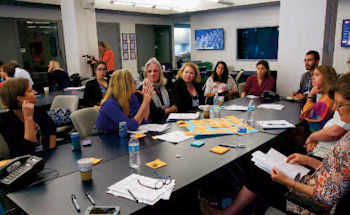SEJournal Online is the digital news magazine of the Society of Environmental Journalists. Learn more about SEJournal Online, including submission, subscription and advertising information.
SEJ News
By MARIA VILLASEÑOR
 |
|
Teams of journalists at the SEJ workshop spent much of the day brainstorming stories, before pitching to a group of top editors. Photo: © Sharon Guynup |
Innovation in environmental journalism was the key theme of a day-long SEJ regional gathering at New York’s CUNY Graduate School of Journalism in July. The event, dubbed “Digital Terrain: Navigating the New World of Environmental Storytelling,” brought more than 70 journalists together for a hands-on workshop that focused on collaborative brainstorming of environmental story ideas for digital platforms.
The day began with inspiration from a group of digital innovators — Charles Homans of The New York Times, “The Adaptors” podcaster Flora Lichtman, WNYC’s Ariana Tobin, Mediastorm’s Joe Fuller and Shane Shifflett of Huffington Post. With the help of moderator and SEJ board member Meaghan Parker of the Wilson Center, the presenters walked participants through the process behind several of their most creative environmental news projects.
The opening talks were meant to serve as a call for those environmental journalists in attendance to explore this new landscape of storytelling techniques, such as using animation to bring complex ideas to life, interactivity to engage audience and shape a story, and unorthodox video to reach untapped communities.
Despite the availability of countless new digital tools, the speakers warned that innovative techniques should be used deliberately and with good reason. Storytelling and journalism basics still matter; use compelling characters and an arc to tell a story that makes people care, they suggested.
Workshop teams collaborate on innovative story ideas
To put these notions to the test, conference-goers then spent the heart of the day working in team breakout sessions to brainstorm, develop and test out engaging digital environmental stories of their own.
Each team worked with environmental-journalist facilitators to develop a pitch for a story that could be told in an engaging way through digital means. Ideas came fast and furious at first, but then over a couple of hours were pared down to a single cohesive story, with its most compelling components and presentation.
Pitches ultimately ranged from a profile of climate impacts on Miami, the infamous glacial “snow mass” in Boston and drought in Puerto Rico, to the environmental footprint of pets, breaking the plastic habit and the explosion of invasive vines.
To get some rough feedback on their pitches and encourage further refinement, each team gave its idea a trial run with another of the breakout groups.
The real test, though, came in a final “pitchfest” session at the end of the day. Each team got a few minutes of rapid-fire feedback from a panel of top editors such as Kevin Berger of Nautilus, Virginia Hughes of BuzzFeed, Brian Storm of MediaStorm, Matthew Schuerman of WNYC and Jennifer Bogo of Popular Science, who moderated the discussion.
Berger, for instance, noted that while he sees plenty of environmental and science pitches, he is always looking for something that makes him care about the story. The notion that audiences share the writer’s empathy for the subject is never enough, he warned — there needs to be an element of the story that makes a person truly want to read it.
BuzzFeed’s Hughes similarly advised writers to make sure their pitches have a sense of immediacy, something that makes the reader feel an emotion very strongly. “The kiss of death for us is the interesting but not urgent story,” she added.
Storm said his company takes the opposite approach to BuzzFeed, preferring to tell long-form tales about “interesting things that aren’t urgent.” He asks himself: Is it universal? Is it something that touches the human condition? And will it be something to talk about 20 years from now?
Medium also matters, as WNYC’s Schuerman pointed out, suggesting that for radio one has to be mindful of stories that play well aurally, for instance by incorporating environmental sounds like those of a beach or a bird. And because radio doesn’t let listeners re-read sentences about complex topics, he said metaphors can be used to break down ideas and give listeners a visual analogy to better understand the story.
The gathering concluded with a wrap-up and a meetup for a dozen or more participants at a nearby watering hole, including many of the workshop’s organizing team, which was led by SEJournal editor and CUNY faculty member Adam Glenn, board members Bogo, Parker, Kate Sheppard of Huffington Post and Gloria Gonzalez of Crain Communications, freelancers Sharon Guynup and Jenny Chen, Rene Ebersole of Audubon and Lois Parshley of Popular Science. Freelancers Sam Eaton and Emily Gertz also served as breakout team facilitators, along with Chen, Glenn, Guynup and WNYC’s Tobin.
María Villaseñor is a former print reporter and now is a freelance multimedia journalist. She recently completed a master’s at the CUNY Graduate School of Journalism and is currently reporting on an investigative series covering mold in NYC public housing for the NY Daily News. Contributing to this report were Rene Ebersole of Audubon and Gloria Gonzalez of Crain Communications.
* From the quarterly newsletter SEJournal, Summer/Fall 2015. Each new issue of SEJournal is available to members and subscribers only; find subscription information here or learn how to join SEJ. Past issues are archived for the public here.












 Advertisement
Advertisement 



